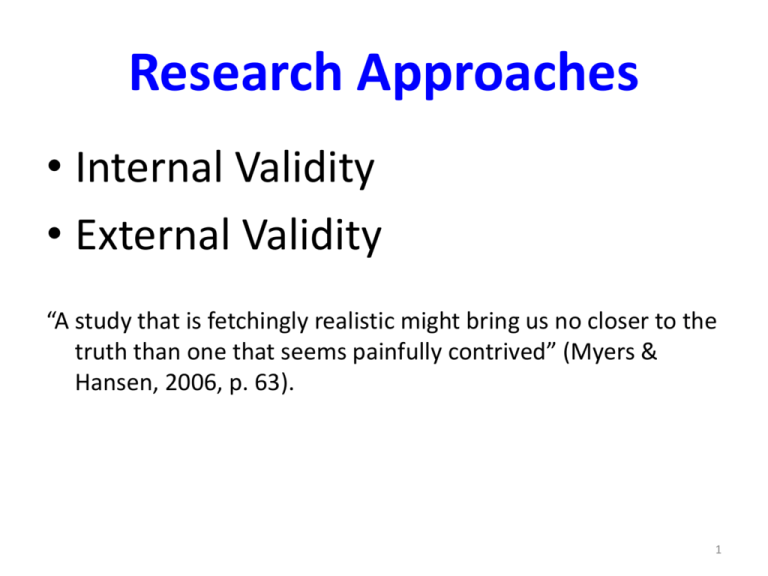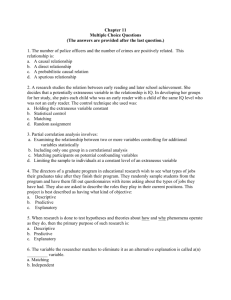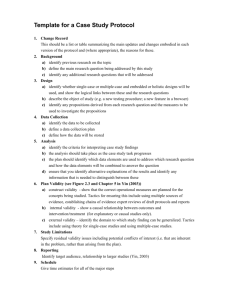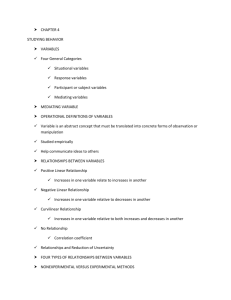Research Ethics Chapter 2
advertisement

Research Approaches • Internal Validity • External Validity “A study that is fetchingly realistic might bring us no closer to the truth than one that seems painfully contrived” (Myers & Hansen, 2006, p. 63). 1 Dimensions of Research • Antecedent Manipulation –Treatments –Independent variable (IV) • Imposition of Units –Behavioral measures –Dependent variable (DV) 2 Imposition of Units Dimensions of Research High Medium Low High/ Low Medium/ Low High/ Medium Medium/ Medium High/ High Medium/ High Low/ Low Low/ Medium Low/ High Low Medium High Antecedent Manipulation 3 Imposition of Units True Experiments High/ High High Medium Low Low Medium High Antecedent Manipulation 4 Nonexperimental Approaches • Phenomenology • Case studies • Field studies – attending to and describing one’s own experience – outside observer records an individual’s experiences & behaviors – research method conducted in the field using a variety of techniques – Field experiments – a type of field study? • Archival studies • Qualitative studies – reexamine existing data for a new reason – data are verbal descriptions rather than numbers 5 Nonexperimental Approaches • Phenomenology Description of one’s own immediate experience Examples: pain in my neck (C5 vertebrae) the Purkinje effect 6 Imposition of Units Phenomenology High Medium Low Low/ Low Low Medium High Antecedent Manipulation 7 Nonexperimental Approaches • Case studies Descriptive records of another individual’s experiences or behavior. Evaluative case studies – case compared to hypothetical “normal” psychological diagnosis – DSM-IV? Now DSM-5 http://www.psychiatry.org/psychiatrists/practice/dsm/dsm-5/onlineassessment-measures Deviant case analysis – deviant case compared to “normal” for significant differences. e.g. Mednick, 1969 – ANS of schizophrenic children functions different compared to normal controls. 8 Imposition of Units Case studies High Medium Low High/ Low Medium/ Low Low/ Low Low Medium High Antecedent Manipulation 10 Nonexperimental Approaches • Field studies Studies done in situ, in real-life settings as opposed to the laboratory. Compare to - A field Experiment in Chicago (p. 86). 11 Imposition of Units Field studies High Medium Low High/ Low Medium/ Low Low/ Low Low Medium High Antecedent Manipulation 12 Nonexperimental Approaches • Naturalistic observation a technique of observing behaviors as they occur spontaneously in the natural setting. e.g. dominance hierarchies in social groups. 13 Imposition of Units Naturalistic Observation High Medium Low Low/ Low Low Medium High Antecedent Manipulation 14 Nonexperimental Approaches • Systematic observation a technique of using specific rules in a prearranged way to objectively record observations. Female sexual receptivity (rodents only) Lordosis- 1. darting, 2. ear wiggling 3. inverted back and 4. tail diversion 15 Nonexperimental Approaches • Participant-observer studies the researcher becomes part of the group being studied. Undercover roid guy… just what baseball needed! 16 Nonexperimental Approaches • Archival study already existing records are reexamined for a new purpose. E.g. data on crime, death rates, education levels, salaries housing patterns and disease rates are accessible to researchers. Bioinformatics Gene database 17 Nonexperimental Approaches Self-reports personal narratives expression of ideas, memories, feelings and thoughts • Qualitative research relies on words rather than numbers Is there a paradigm shift occurring? 18 Phenomenology is used as part of qualitative research Contemporary or Empirical Phenomenology 1. Researcher self-reflects on experiences related to the phenomenon 2. Others provide verbal or written descriptions of experiences 3. Accounts of the phenomenon are gathered from literature, art, television, the internet and other sources 19 Correlational and QuasiExperimental Designs Chapter 5 20 Correlational Designs Determine the degree of relationship between two traits, behaviors or events; predict one set from another. • Antecedents are preexisting • Degree of imposition of units - high • Tend to be higher in external validity 21 Correlational Designs Imposition of Units High Low/ High Medium Low Low Medium Antecedent Manipulation High 22 Quasi-experimental Designs Can seem like an experiment, but subjects are not randomly assigned to treatment conditions. • Antecedent control varies • Degree of imposition of units - high • Tend to be higher in external validity 23 Quasiexperimental Designs Imposition of Units High Low/ High meduim/ High Low Medium Medium Low Antecedent Manipulation High 24 Example of a Quasiexperiment Lighting condition – fluorescent vs incandescent. Subjects – from company A (fluorescent lights) or B (incandescent). Performance measure – productivity. Can cause-effect be established with confidence? 25 Pearson Product-Moment Correlation Coefficient (r ) Most common procedure for calculating simple correlations – relationship between pairs of scores for each subject. Three outcomes are possible: • Positive relationship • Negative relationship • No relationship 26 Scatterplots Visual representations of the scores belonging to each subject in a study. Each dot = two scores (x,y) from one subject. • One score places the dot along the horizontal axis (x) and the other score places it along the vertical (y) axis. • Regression lines (of best fit) represent the mathematical equation that best represents the relationship between the two measured scores. 27 Hypothetical Relationships B. Positive r = +.69 Variable Y Negative r = -.72 Variable Y A. Variable X No correlation r = -.02 Variable Y C. Variable X Variable X 28 Four possible causal directions of a correlation • 1) 2) 3) 4) Given a strong positive relationship between childhood aggressiveness and watching violent TV (r = +.70). Watching violent TV aggressiveness Aggressiveness watching violent TV Aggressiveness watching violent TV Both are caused by a third variable (unknown or not measured, e.g., parental supervision) 29 Coefficient of determination • • • • Estimates the amount of variability in scores on one variable that can be explained by the other variable. E.g., if r = .56, then r 2 = .31. 31% of the variability in scores on variable X can be accounted for by variable Y. An r 2 ≥ .25 can be considered a strong association. 30 Variable Y: calculate mean and S Regression equation Positive r = +.56 Y Y intercept slope X Variable X: calculate mean and S 31 Regression Equation • Given the score on one variable you can predict the score on the other if you know: – The value of r – Average scores of X and Y (the means) – Standard deviation (S) of X and Y Y = Y + r [Sy / Sx] (X – X) 32 Multiple Regression • • • Used to predict the score on one behavior from the scores on others included in the analysis. The regression equation provides beta weights for each predictor (indicating their importance) Beta weights can simply be reported or used in an advanced correlational analysis to construct causal sequences for the behaviors. 33 Multiple Correlation • • • Intercorrelations among 3 or more behaviors (R) Can not explain why the 3 measures are related but it may suggest that a “third variable” is important. Influence of one variable is held constant while measuring the correlation between the other two – partial correlation 34 Causal Modeling • • Advanced correlational techniques provide information about the direction of the cause and effect sequences among variables. Two techniques: 1. Path analysis 2. Cross-lagged panel designs 35 Path Analysis • • • Creates models of possible causal sequences when several related behaviors are measured Beta weights from multiple regression analysis are used to evaluate the direction of cause and effect from correlated variables. Internal validity is low (correlational data), consequently causal statements can not be made. 36 Path Analysis Perceived Risk .25** .20* .30** Monitoring * p < .05, ** p < .01 Intrusive Thoughts .37** Psychological Distress Internal validity? Third variables? From Schwartz, Lerman, Miller, Daly, and Masny (1995) 37 Cross-Lagged Panel Design • • • • Uses relationships measured over time to suggest causal models. The same pair of related behaviors or characteristics are measured at two separate time points for each subject. Can only suggest the direction of causal relationships (not conclusive). Bidirectional causation and the third variable problem cannot be ruled out. 38 Cross-Lagged Panel Design Age 3 Age 8 r = .14 Time watching TV r = .20 Time watching TV r = .05 r = .07 Size of Vocabulary r = .41 Size of Vocabulary Hypothetical Cross-Lagged Panel design 39 Quasiexperimental Designs • • • • Subjects cannot be randomly assigned to different treatments Quasi-treatments are formed based on a particular event, characteristic or behavior of interest. E.g., gender differences in sleep patterns. Low internal validity. 40 Quasiexperimental Designs • • Subjects may be exposed to different treatments, but without random assignment (e.g. the lighting-productivity study) There is a lack of control over other potential confounds (i.e., an inability to hold all else constant except for the treatment condition). 41 Ex Post Facto Studies • • • • Ex Post Facto – systematic examination of the effects of subject variables (characteristics) without manipulation. Low Antecedent Manipulation High Imposition of Units Greater external validity 42 Nonequivalent Groups • • • A manipulation is carried out but subjects are not randomly assigned to groups E.g. the lighting experiment yet again Internal validity can be increased by controlling extraneous variables after careful consideration of potential confounds. 43 Longitudinal Designs • • • • Measure the behavior of the same group of subjects across time. A form of within-subject design Important for studying growth and development and aging Retaining subjects may be difficult 44 Cross-sectional Studies • • • Investigates changes across time by comparing groups of subjects already at different stages at a single point in time. Typically requires more subjects than the longitudinal study. Subjects may differ in ways other than those being studied (similar to Ex post facto). 45 Pretest/Posttest Design • Investigates the effects of a treatment by comparing behavior before and after the treatment. • Practice effects (pretest sensitization) • Outside influences cannot be ruled out • Low internal validity e.g., exposure to cocoa on cognitive performance 46









